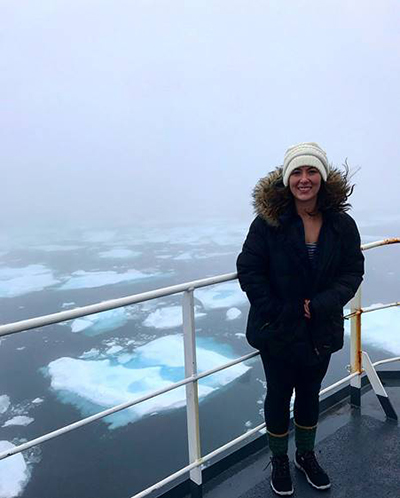
Emily Bolger
Track: Climate and Society
Graduated: December 2018
What is your current job/project and main responsibilities? Please tell us as much as you like about what you are doing.
I am currently working as a physical scientist in the Energy and Resilience Unit under the Air and Radiation branch at Region 1 of the US Environmental Protection Agency (EPA) located in Boston, MA. My primary role is to reduce New England’s emissions from electric generating units through working as the regional ENERGY STAR representative. ENERGY STAR is an EPA backed program that provides tools and resources that help homes, businesses, and industrial plants to identify cost-effective approaches to manage energy consumption and increase savings. As the regional representative, I provide technical support for ENERGY STAR’s portfolio manager which is an energy benchmarking tool that allows you to securely track and assess energy and water consumption across your building portfolio. At the EPA, I also work on climate resilience through organizing and leading internal meetings on climate and quarterly calls between regional climate representatives.
Tell us about your MPS internship, and in what way did it help you develop professional skills and connections?
For my MPS internship, I conducted a research project on how aerosols affect cloud seeding and ecosystems. The scientific definition for an aerosol is any solid or liquid particle suspended in the atmosphere. When it comes to climate, aerosols interact both directly and indirectly with Earth’s radiative balance and climate system. However, aerosols and aerosol-cloud interactions remain as one of the least understood processes within the climate system. Future measurements and process-level studies are necessary to reduce the uncertainties in both the direct forcing of aerosols, the ability of aerosols to seed cloud droplets and ice crystals, and the role of aerosols on ecosystem health. For my internship, I had the privilege of working under two brilliant female scientists - Dr. Cassandra Gaston at the University of Miami and Dr. Jessie Creamean at the National Oceanic and Atmospheric Administration (NOAA). I was given the opportunity to have a wide geographic research area that ranged from Africa all the way to the Arctic. While studying aerosol-cloud interactions in the Arctic, I boarded the US Coast Guard Cutter Healy for a 3-week research expedition in the Arctic Ocean. It was through the MPS program that I was given a once in a lifetime opportunity where I got to experience first-hand the most rapidly changing environment on Earth.
What was your MPS track?
Climate and Society
What are your favorite Rosenstiel School memories?.
Being in a brand-new city, Rosenstiel School really makes you feel at home. Whether it’s grabbing a beer after class or studying with your friends at the library – Rosenstiel School really provides a community. Being surrounded by a group of like-minded and enthusiastic individuals added so much value to my graduate school experience. Plus, who doesn’t love going to school on the beach!
What were your favorite classes at Rosenstiel School and why?
Some of my favorite courses at Rosenstiel School were Climate Change, Climate & Society, and Environmental Communication. These courses allowed me to understand the full problem of climate change beyond just the science. Coming out of Rosenstiel School , I felt empowered to tackle the problem of climate change in the real world as a both an informed scientist and trained communicator.
What piece of advice would you give to current or incoming MPS students?
Before starting the program, ask yourself what you’re interested in and start communicating your interests to your advisor right away. The MPS program is entirely what you make of it, and it is up to you to take advantage of the amazing opportunities and resources that Rosenstiel School has to offer. Also, never be afraid to ask for help! Everyone at Rosenstiel School wants you to succeed so just ask the questions!




